Lawn Care and Dogs
Original article by S. Veigel (Revisited) June 6, 2021
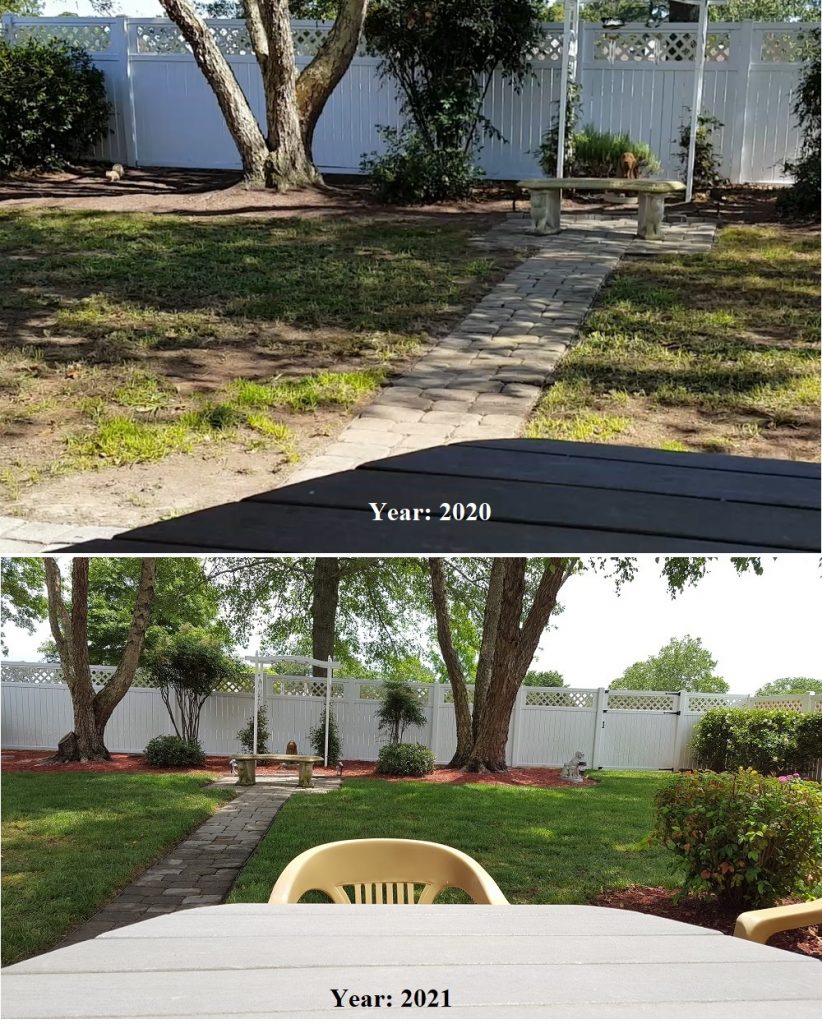
So in the article Dog Path (posted in 2017) I detailed a DIY project that actually changed dog behavior (or took advantage of observed natural behavior). Now that I had a walkway and cleaned things up it was time to tackle the grass. But even though I had a good start it would actually be 4 years later that I felt I could really impart what I learned here and show you the results.
4 Years? Ok. I was also busy with lots of other things. Also dogs, trimming, planting and planning the money. One step at a time.
I think the best examples of any project are the ones with a really bad looking starting point. The biggest challenge always works best when contrasted with a great result. Take a moment to enlarge some of the photos as you read this. To get a good look at what I’m talking about.
I’m going to cover some subject territory here but I think it’s worth it. For those who want to skip through things, I have section headings to help you out. But you might want to come back later and look at a little more detail.
I: What is Urine Burn – This Is Not Urine Burn
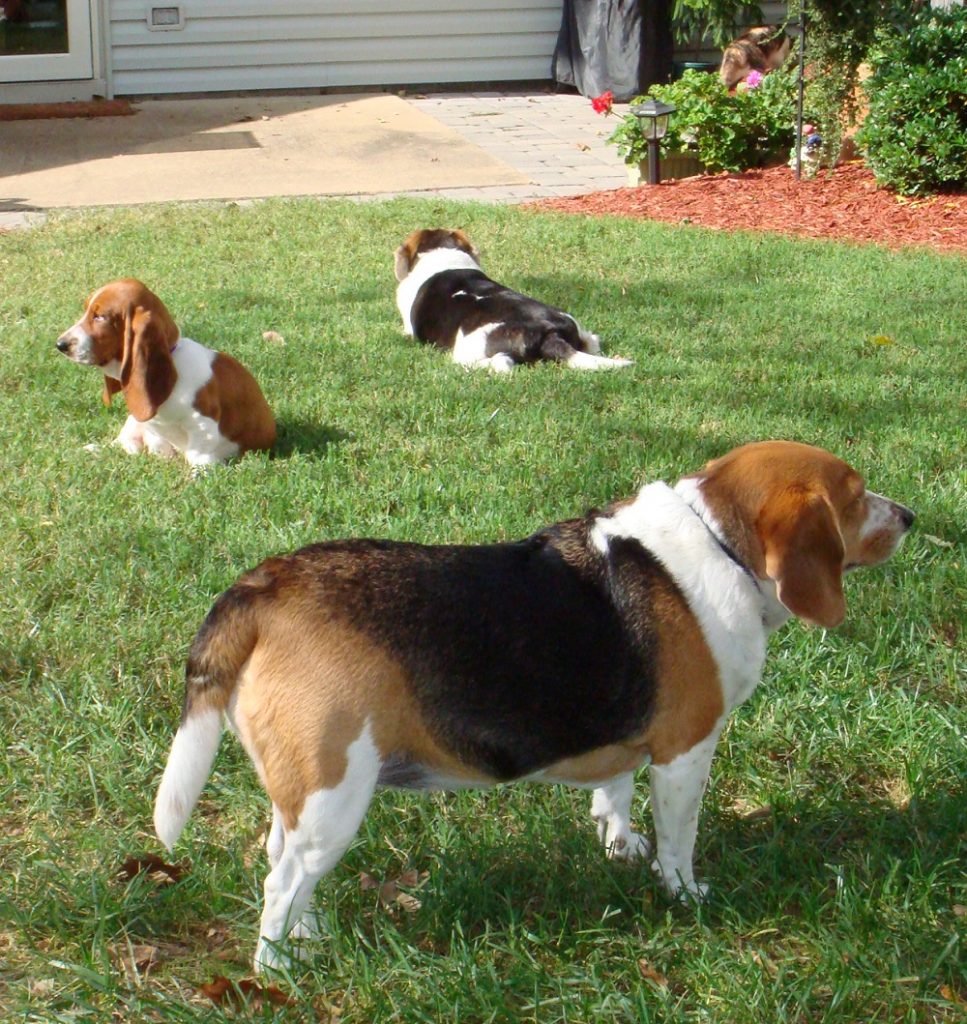
Before the field of dirt you saw in the first picture (above) I thought I had a fairly decent lawn out back. In this picture on the left you see some of our dogs. In the upper right our cat, Scooter, is poking around in the garden. The grass doesn’t look that bad but if you look closely you’ll see thin grass and patches of brown dead grass which people far too often attribute to dogs and “Urine Burn”.
“Urine Burn” is when grass dies because dogs urinate on the grass in hot weather. Many web posts have attributed this to acid or ammonia content in their urine, but it’s not. So don’t start spreading lime to neutralize it. It’s a waste of money and time. And it doesn’t work.
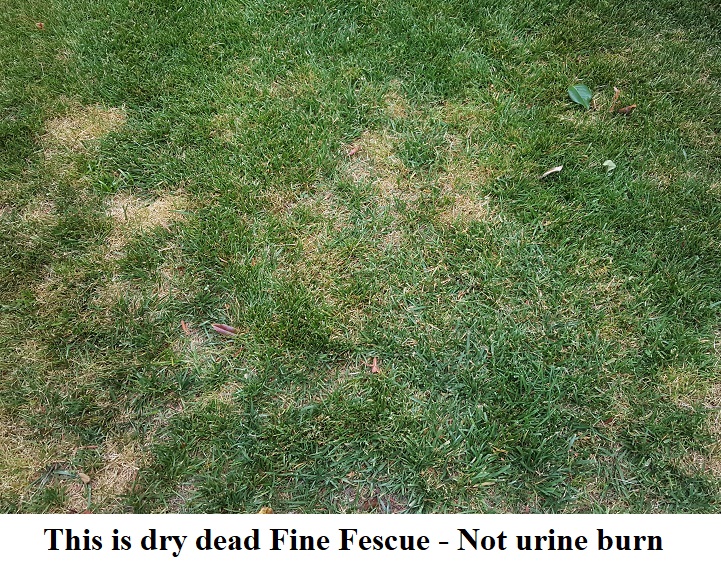
There are actually 3 reasons for what people call urine burn. The first reason is that dog urine contains nitrogen. As a matter of fact, all meat eating creatures have nitrogen in their urine. So don’t buy pills or formulas to make your dog’s urine lawn friendly. Its digestive system doesn’t need you to mess with it. A better solution (if it’s a problem) is to keep a can of water by the back door and sprinkle a little water where they just peed. An even better solution is to read on and take some of my advice.
The second reason for urine burn is the dry heat stressing out delicate thin grasses like “Fine Fescue” and “Poa Annua” (AKA Annual Bluegrass). These are delicate grasses and first to go when a dog urinates in hot weather.
The third reason people think they’re seeing urine burn is that they mow the grass way too short denying the grass the ability to handle heat stress. This also makes it more vulnerable to urine burn.
All that thin brown grass in the 2 pictures on the left did not occur with dogs walking around urinating in different locations. But when I started seeing obvious spots that looked like dribble spots I had to start understanding urine burn. I just didn’t know that I, not so much the dogs, was creating the conditions for that to occur.
II: Not All Nitrogen Is Good For Plants
78% of our atmosphere is nitrogen. But this air nitrogen is not all useable to plants. The intense power of lightning (5 times hotter than the surface of the sun – which occurs somewhere in the world every day) breaks down the nitrogen gas molecule in a process called nitrogen fixation. Basically oxygen and the now “reactive nitrogen molecules” combine to form nitrogen dioxide, gets captured in rain drops and then falls to be absorbed into the soil.
There’s a little more to making nitrogen gas useable in the soil but I’m not going to do it justice here. There are also organisms called “Decomposers” that break down urine and feces into ammonia and converts that to nitrates. Eventually water soaked soil returns nitrogen back to the atmosphere. But this is all getting a bit technical.
The bottom line is that too much of any kind of nitrogen will “burn” your grass, shrivel roots, increase vulnerability to disease and make it difficult to tolerate temperature extremes.
III: Enter the Destroyer
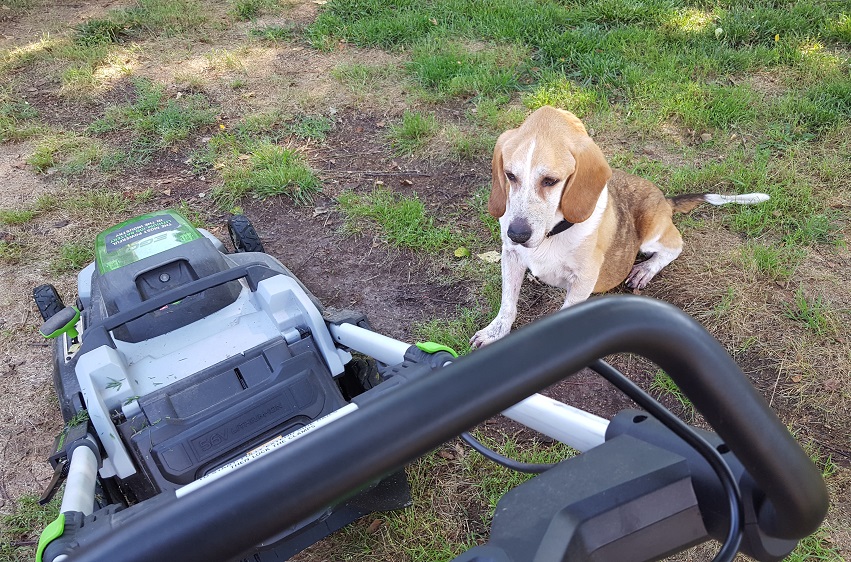
So now we have grass that is too short, some dog pee, fine fescue and Poa Annua. What else could go wrong? Something that loves dog feces?
While I was incorrectly fixated on “urine burn” I started noticing swaths of grass browning in progressively large areas. Beetles! I didn’t count on beetles. Not the ones I see above ground. The eggs they lay underground, the eggs that then hatch and become grubs (baby beetles, June Bugs, etc.). Grubs that then munch their way through the root system of your grass.
I will to my dying day and beyond claim that I spent a lot of time with my dogs and I was very diligent about cleaning up the dog poop. But beetles in the yard were not new and I was never raised to treat my yard for grubs. Before all of this I honestly didn’t think it was a problem. I also thought for a time the damage to the grass might in part be the trees we planted. Maybe there was too much shade for the grass to grow. But everything together created the perfect storm you saw in the first picture of “the field of dirt” (above). And coming back from it all involved a bit of a learning curve. It also provided a learning opportunity.
IV: What You Need to Know About Poa Annua
Poa Annua is sometimes called annual Bluegrass. It thrives in cool weather so it invades your lawn when your good grass is dying back. Poa Annua turns brown in hot weather and the seeds stay in the ground for up to 5 years. Poa Annua grows in clumps. New grass in cool weather, turning brown and dying in hot weather, then new grass again in the same spot, dying again. An endless cycle building up these clumps layer by layer, year after year.
Does your lawn mower bounce over bumpy ground? Pull on some of that brown grass and see if it doesn’t come up like a throw rug.
V: So Don’t Blame The Dog Or The Trees For These Things
1]: Cutting the lawn too short.
2]: Fine Fescue or Poa Annua.
3]: Grubs.
4]: Hot dry weather.
5]: Failure to keep the poop cleaned up.
6]: Inadequate water.
7]: Watering too late in the day.
Any of these things may make you think you have urine burn and lead you down the wrong road to recovery.
VI: Let’s Get Started – Yard Prep
1]: Do not assume you don’t have a grub problem. There are always beetles and therefore always grubs. If you do a web search on when to apply grub killer it’s pretty easy to find a chart based on your Zone (State). Scotts’ and Bayer’s Season-Long products recommend that you apply grub killer between the first of April and the end of May. Also no later than July 15.
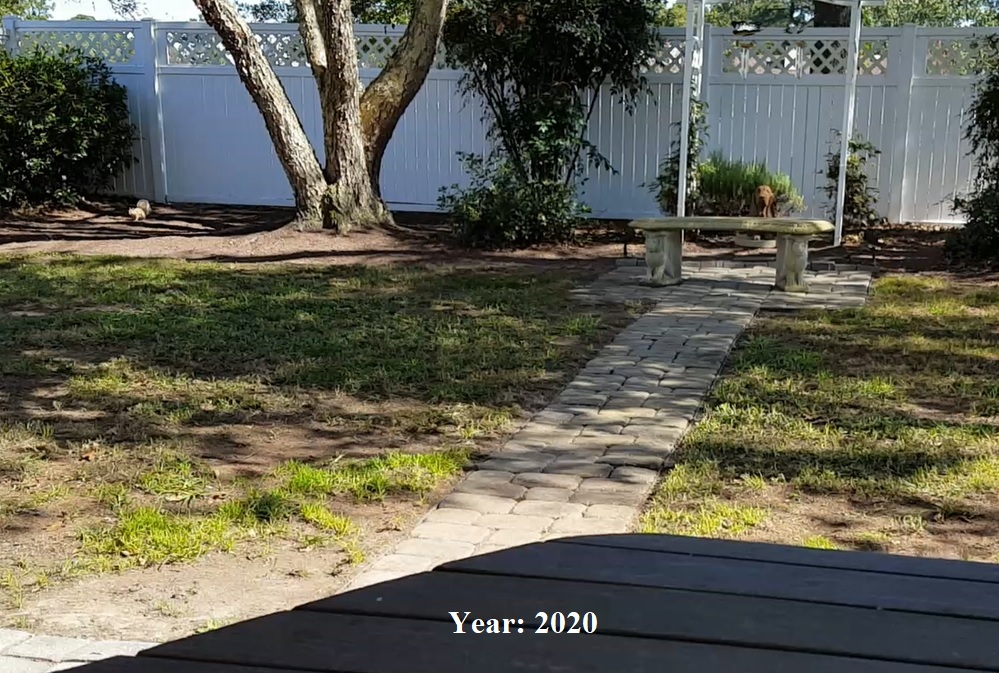
2]: If you have a rough start like my “field of dirt” hard rake the yard before you plant grass seed. I had a “yard expert” pause when I said this, but once you have clumps of Poa Annua and every stringing or shallow root grass in your yard you need to open up some ground.
My pre-seeding philosophy is, once I have a real problem, “If it comes up with a hard rake, I don’t want it.”
Also, maybe rethink using a Rototiller to prep the ground. If you have all the issues going on that I did you don’t really want to till annual Bluegrass back into the ground.
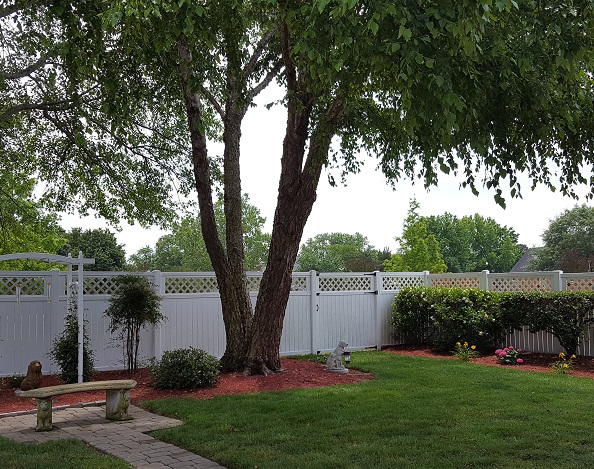
3]: Trees. Trees are great if you do something with them. If you have to duck under a tree limb, that limb has to go. A well-groomed tree with plenty of height will have the limbs cut off as high as 11 feet. This provides for more sunlight to gardens and grasses and opens up air flow while still providing shade. It also almost eliminates those pesky spider webs that are strung from a tree limb to the ground. Part of a great lawn? Absolutely.
4]: Treat Poa Annua with a pre-emergent. In the spring (but not when you’re seeding).
5]: DO NOT bother seeding in the spring or summer. The best time for seeding is around October 15 (give or take). It’s cooler, there’s still plenty of moisture and ample time for the seed to establish deep roots before a hot summer.
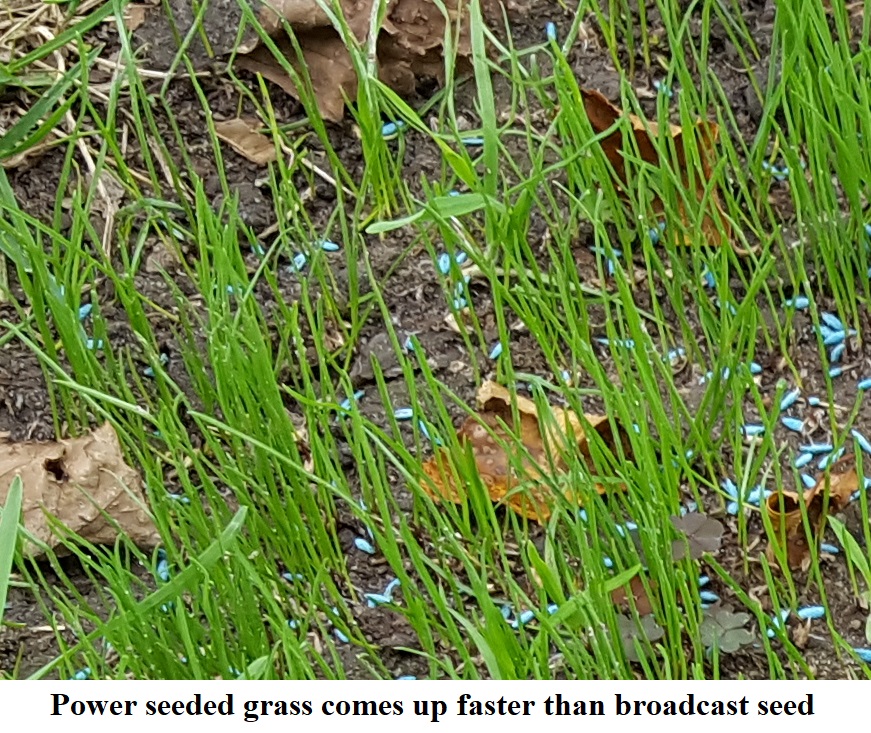
6]: If possible use a power seeder or a lawn service to power seed the area. This gets the seed actually in the ground. After power seeding broadcast more grass seed on top of the ground. Most professional lawn services will also do both.
7]: You must water new seed daily or as much as possible (preferably before 7 in the morning). If there’s a heavy rain wait a couple days before watering again. This does not require a sprinkler on for 30 minutes. Watering new seed doesn’t require much. But you want to keep the ground fairly wet or your new grass won’t have deep roots.
When you water new seed never use a spray nozzle unless you point it up and just let the drops fall onto the ground. When I do this I just attach a watering wand. The kind you water outdoor flower pots with. I use a bare spot next to or in the grass to see how much water I’m laying down.
Here’s how: I move the watering wand slowly back and forth looking to see how many times I need to pass over that strip of grass. I gage that by the puddle I see in a bare spot and how fast it sinks in the ground. With this wand attachment I usually find that I want to pass over an area about 3 to 5 times max remembering that I don’t want to wash away the seed, just wet the ground good. After, say, 3 passes I step back and repeat the process strip by strip.
Using a wand attachment instead of a sprinkler may seem like too much work, but it’s really a very peaceful moment playing with the water. And I can water my front yard, back yard, north side of the house and the south side of the house in less than an hour.
Remember. You’re not watering a full established lawn for maintenance 30 minutes. You’re wetting new seed every morning just to keep pulling the roots down.
If you prefer a sprinkler, watch how much water you’re applying every morning. Don’t overdo it.
VII: That’s Why They Call it Fall
Planting seed around October has all the advantages. But it also means you may have leaves covering the seed now (depending on the type of tress in the area). Don’t worry about it. You don’t have to remove all the leaves and you definitely should not rake them.
Here’s what you should do:
1]: Above all wait until you see new grass growing (about 2 weeks).
2]: To keep dry material and seed from blowing around needlessly water first.
3]: Don’t worry about all the leaves. Just focus on areas with the most leaves clumped together.
Use a leaf blower on its lowest setting and blow at an angle. Maybe raise and lower the blower slowly so you can control and direct the air movement as needed instead of steady on (Don’t blow hard straight down on the leaves and your seed).
4]: Only worry about breaking up the clumps suffocating areas. You’ll still have leaves in the yard but if it is scattered you should be fine.
VIII: A Word About Seeding With Multiple Dogs
Obviously if you have multiple dogs who need to get out of the house once in a while they can complicate your seeding efforts. Don’t get frustrated. Get smart. Buy some chicken wire and metal fence posts to divide the yard. Seed one side, let the dogs have the other. It’s more hassle and takes longer but you can have multiple dogs and get it done.
My problem was, once when I tried to patch an area with chicken wire corralling the grass seed, I’d look out the window and see my 2 Beagles inside the fence nibbling new grass. As if the rest of the yard wasn’t good enough?! Realizing they were lifting up the chicken wire so they could crawl under I got some plastic stakes (like you buy for patio and walk rails) and staked down the fencing in various locations so they could not crawl under it anymore.
But if I left them out there long enough I’d find myself laughing and scratching my head trying to figure out how those Beagles got in again.
VIIII: Last of all – Mow It Don’t Kill It
Years ago I was talking to a neighbor about how I was mowing my lawn higher to “let it have some chlorophyll” to live on. He responded, “I like to mow my lawn short so I don’t have to mow it as often.” “How often do you mow it?” I asked. “Once a week, once every 2 weeks?” “Once a week.” He answered.
Puzzling over his thought process for a moment I carefully edged in with my next question. “So, if you mow it every week anyway, how is that making it so you don’t you don’t have to mow as often?” My neighbor was stumped for a moment as I closed with my last question. “I mean, you’re mowing every week anyway, why not let it grow a little longer and green up?”
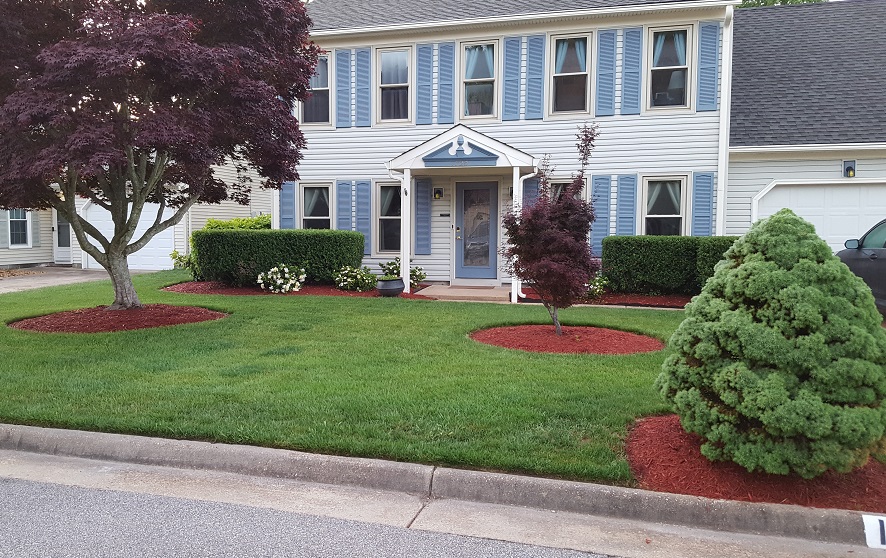
Yard services and experts say you should mow your lawn 3 inches high. One even gave me a little card with measurements on it so I see how tall my grass should be when I mowed. The only problem with that is, at the highest setting on my lawn mower I can’t get 3 inches high. So I just keep it at the highest setting and leave it there. No matter. It’ll be 3 inches by the time I mow again.
Note: There are complicated charts on the web for mowing heights at different times of the year and different heights to start mowing new grass depending on the type of grass. You don’t have to get this precise. Before you mow new grass just let it grow about 2-3 inches and look at the seed still on the ground to see if you think you can do it without blowing the rest away. If the seed looks like it is stuck down with some rooting started between the longer new grasses you may be ok. The worst that can happen at that point is that you may want to spread some more grass seed in later.
The picture on the left here show my lawn mowed at the highest setting and there’s no difference between mowing times. Does that really look bad letting the grass grow taller and therefore greener? Of course not. Let it grow. Let it get stronger not just greener.
It’s really just a matter of getting used to your grass being a plant you’d like to keep.